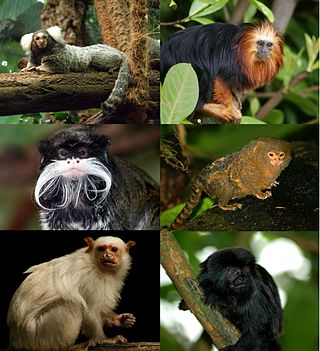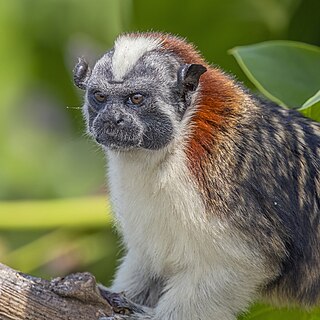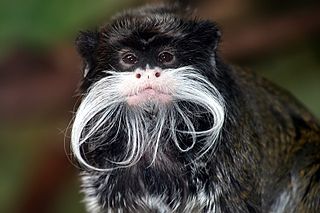Related Research Articles

The Callitrichidae are a family of New World monkeys, including marmosets, tamarins, and lion tamarins. At times, this group of animals has been regarded as a subfamily, called the Callitrichinae, of the family Cebidae.

Geoffroy's tamarin, also known as the Panamanian, red-crested or rufous-naped tamarin, is a tamarin, a type of small monkey, found in Panama and Colombia. It is predominantly black and white, with a reddish nape. Diurnal, Geoffroy's tamarin spends most of its time in trees, but does come down to the ground occasionally. It lives in groups that most often number between three and five individuals, and generally include one or more adults of each sex. It eats a variety of foods, including insects, plant exudates, fruits and other plant parts. Insects and fruits account for the majority of its diet, but exudates are also important. But since its teeth are not adapted for gouging trees to get to the sap, it can only eat exudates when they are easily available.

The tamarins are squirrel-sized New World monkeys from the family Callitrichidae in the genus Saguinus. They are the first offshoot in the Callitrichidae tree, and therefore are the sister group of a clade formed by the lion tamarins, Goeldi's monkeys and marmosets.

The cotton-top tamarin is a small New World monkey weighing less than 0.5 kg (1.1 lb). This New World monkey can live up to 24 years, but most of them die by 13 years. One of the smallest primates, the cotton-top tamarin is easily recognized by the long, white sagittal crest extending from its forehead to its shoulders. The species is found in tropical forest edges and secondary forests in northwestern Colombia, where it is arboreal and diurnal. Its diet includes insects and plant exudates, and it is an important seed disperser in the tropical ecosystem.

Erysipelothrix is a genus of bacteria containing four described species: Erysipelothrix rhusiopathiae, Erysipelothrix tonsillarum, Erysipelothrix inopinata and Erysipelothrix larvae. Additional species have been proposed based on DNA-DNA hybridization studies. "The hallmark of Erysipelothrix is the presence of a type B cell wall, in which the peptide bridge is formed between amino acids at positions 2 and 4 of adjacent peptide side-chains and not, as in the vast majority of bacteria, between amino acids at positions 3 and 4."

The white-footed tamarin is a tamarin species endemic to Colombia. It is a silvery brown colour with pale streaks and russet underparts, and is very similar in appearance to the cotton-top tamarin, from which it is separated by the Atrato River. It is thought that the two species diverged during the Pleistocene, at a time when a sea occupied the area between their present ranges. This tamarin is an arboreal species, living in small family groups in the canopy. Females give birth to one to three young after a gestation period of about 140 days. This species has a relatively small range and is under threat from destruction and fragmentation of the forest in which it lives and the International Union for Conservation of Nature has assessed its conservation status as "vulnerable".

The Bacillaceae are a family of gram-positive, heterotrophic, rod-shaped bacteria that may produce endospores. Motile members of this family are characterized by peritrichous flagella. Some Bacillaceae are aerobic, while others are facultative or strict anaerobes. Most are not pathogenic, but Bacillus species are known to cause disease in humans.

Cardiobacterium hominis is a Gram-negative bacillus (rod-shaped) bacterium commonly grouped with other bacteria into the HACEK group. It is one of several bacteria that is normally present in the mouth and upper part of the respiratory tract such as nose and throat. However, it may also rarely cause endocarditis, an infection of the heart valves.
Gemella is a genus of Gram-positive bacteria that thrive best at high partial pressure of CO2.

The Proyecto Tití was founded in 1985, to provide information to assist in conservation of the cottontop tamarin and their habitat in the tropical forests of Colombia. Proyecto Tití's programs combine field research, education and community programs. The cotton-top tamarin, is one of the most endangered primates in the world and is found only in North-Western Colombia.
Naxibacter varians is a Gram negative, nonmotile rod-shaped, non-spore-forming, and oxidase positive bacterium from the Oxalobacteraceae family, which was isolated from clinical specimens and water samples.

Massilia albidiflava is a Gram-negative, rod-shaped, oxidase and catalase positive, non-spore-forming motile bacterium from the genus Massilia and the family Oxalobacteraceae which was isolated with Massilia dura, Massilia plicata, and Massilia lutea from soil samples in southeast China.
The species of the genus Aquabacterium are motile, rod-shaped, Gram-negative, oxidase-positive, catalase-negative bacteria which were isolated from drinking water biofilms in Berlin. Identified species include Aquabacterium citratiphilum, Aquabacterium parvum, and Aquabacterium commune. Three bacterial strains isolated from biofilms of the Berlin drinking water system were characterized with respect to their morphological and physiological properties and their taxonomic position. Phenotypically, the bacteria investigated were motile, Gram-negative rods, oxidase-positive and catalase-negative, and contained polyalkanoates and polyphosphate as storage polymers. They displayed a microaerophilic growth behaviour and used oxygen and nitrate as electron acceptors, but not nitrite, chlorate, sulfate, or ferric iron. The substrates metabolized included a broad range of organic acids, but no carbohydrates at all. The three species can be distinguished from each other by their substrate use, ability to hydrolyse urea and casein, cellular protein patterns, and growth on nutrient-rich media, as well as their temperature, pH, and NaCl tolerances. Phylogenetic analysis, based on 16S rRNA gene sequence comparison, revealed that the isolates are affiliated to the beta 1-subclass of Proteobacteria. The isolates constitute three new species with internal levels of DNA relatedness ranging from 44.9 to 51.3%. It is proposed that a new genus, Aquabacterium gen. nov., should be created, including Aquabacterium citratiphilum sp. nov., Aquabacterium parvum sp. nov., and Aquabacterium commune sp. nov. The type species of the new genus is Aquabacterium commune.
Achromobacter spanius is a Gram-negative, oxidase- and catalase-positive, rod-shaped bacterium from the genus Achromobacter isolated from various human clinical samples.
Brackiella is a genus of Gram-negative, oxidase- and catalase-positive, rod-shaped bacteria from the family of Alcaligenaceae with one known species.
Psychrobacter is a genus of Gram-negative, osmotolerant, oxidase-positive, psychrophilic or psychrotolerant, aerobic bacteria which belong to the family Moraxellaceae and the class Gammaproteobacteria. The shape is typically cocci or coccobacilli. Some of those bacteria were isolated from humans and can cause humans infections such as endocarditis and peritonitis. This genus of bacteria is able to grow at temperatures between −10 and 42 °C. Rudi Rossau found through DNA-rRNA hybridization analysis that Psychrobacter belongs to the Moraxellaceae. The first species was described by Juni and Heym. Psychrobacter occur in wide range of moist, cold saline habitats, but they also occur in warm and slightly saline habitats.
Psychrobacter phenylpyruvicus is a Gram-negative, catalase- and oxidase-positive, nonmotile bacterium of the genus Psychrobacter, which was isolated from human blood in Belgium. Psychrobacter phenylpyruvicus can cause humans infections such as endocarditis, peritonitis, and fungating lesion of the foot, but those infections caused by this bacterium are rare.
Paraperlucidibaca wandonensis is a Gram-negative, strictly aerobic, catalase-negative, oxidase-positive, rod-shaped, nonmotile bacterium of the genus Paraperlucidibaca.
Bartonella bovis is a pathogenic bacteria first isolated from European ruminants. It is small, fastidious, aerobic, oxidase-negative, gram-negative and rod-shaped. Its type strain is 91-4T.
Aliiglaciecola litoralis is a gram-negative, aerobic, non-pigmented, catalase- and oxidase-positive, rod-shaped motile bacterium from the genus of Aliiglaciecola which was isolated from a marine sandy sample of the Sea of Japan. Aestuariibacter litoralis has been reclassified to Aliiglaciecola litoralis.
References
- ↑ "LPSN LPSN" . Retrieved 2013-07-30.
- ↑ "Straininfo of Brackiella oedipodis". Archived from the original on 2016-03-04. Retrieved 2013-07-30.
- 1 2 Willems, A; Gilhaus, H; Beer, W; Mietke, H; Gelderblom, HR; Burghardt, B; Voigt, W; Reissbrodt, R (2002). "Brackiella oedipodis gen. nov., sp. nov., gram-negative, oxidase-positive rods that cause endocarditis of cotton-topped tamarin (Saguinus oedipus)". International Journal of Systematic and Evolutionary Microbiology . 52 (1): 179–186. doi: 10.1099/00207713-52-1-179 . PMID 11837301.
- ↑ "Taxonomy - Brackiella oedipodis (species)". UniProt.
- ↑ EurekaMag.com Science Magazine